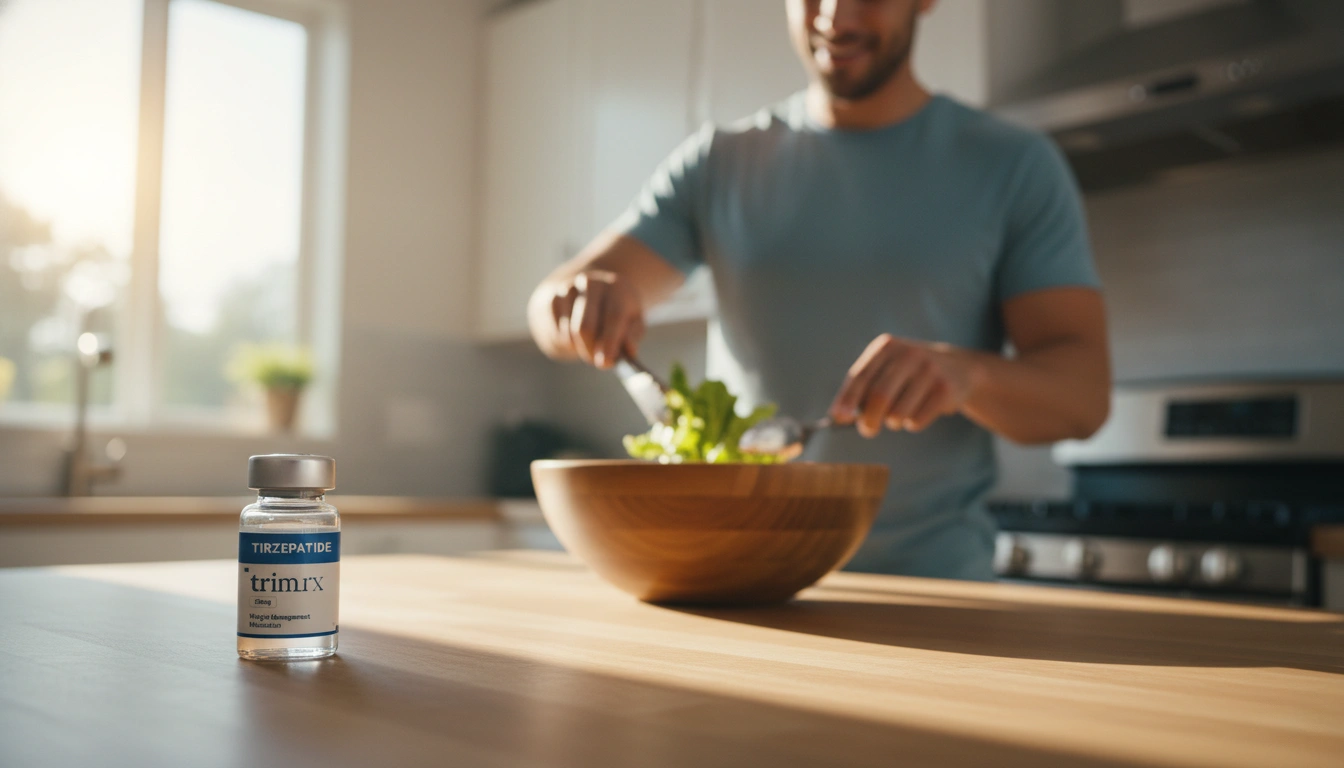What Not to Eat on Tirzepatide: Key Dietary Choices for Optimal Results

Introduction
Weight loss medications like tirzepatide have rapidly gained attention due to their effectiveness in supporting sustained weight reduction. However, the real secret to maximizing tirzepatide's benefits—and minimizing side effects—lies just as much in what you eat as in the medication itself. Have you ever wondered why some people achieve remarkable weight loss with tirzepatide while others struggle? The answer often comes down to dietary choices.
Tirzepatide works by influencing hormones that regulate appetite and digestion, but certain foods can undermine its effects or exacerbate side effects like nausea and digestive discomfort. At TrimRx, we believe that sustainable weight loss is rooted in science, empathy, and a tailored approach. Combining clinically proven medications like tirzepatide with personalized nutrition and lifestyle strategies provides the safest path forward.
This post will guide you through what not to eat on tirzepatide, highlighting foods that may interfere with the medication’s effectiveness or cause unwanted side effects. We will also cover the importance of a nutrient-dense, balanced diet and offer practical tips to navigate this journey alongside tirzepatide. By the end, you’ll understand how to fuel your body wisely to enhance your weight loss journey—and why taking our free personalized assessment quiz is a great first step to see if tirzepatide aligns with your health goals.
Together, we’ll explore the eating habits to avoid, foods to embrace, and strategies to address common side effects, providing you with a comprehensive roadmap for success.
Understanding Tirzepatide and Its Role in Weight Loss
Tirzepatide is an innovative prescription medication that functions as a dual glucose-dependent insulinotropic polypeptide (GIP) and glucagon-like peptide-1 (GLP-1) receptor agonist. By mimicking these natural hormones, tirzepatide enhances feelings of fullness, slows gastric emptying, and improves blood sugar regulation. This dual action helps reduce appetite and supports weight loss effectively.
It is important to emphasize that tirzepatide is designed to be used as part of a holistic approach, including a healthy diet and physical activity. Medications like tirzepatide are not “magic bullets”—rather, they are tools that harmonize with lifestyle changes to produce meaningful and sustained results.
Given that tirzepatide slows digestion and affects appetite signals, the interaction with certain foods becomes crucial. Ingesting foods that spike blood sugar, are difficult to digest, or cause gastrointestinal irritation can either blunt tirzepatide’s benefits or intensify side effects such as nausea and indigestion.
At TrimRx, our mission is to support every individual’s unique weight loss journey through personalized, medically supervised programs. We encourage you to take our free assessment quiz to check if you qualify for our prescription weight loss medications, including tirzepatide, compounded semaglutide, Ozempic®, and others. This quiz is a key first step towards tailoring a safe and effective treatment plan just for you.
Why Diet Matters When Taking Tirzepatide
Because tirzepatide impacts digestion and appetite, your diet directly influences how well you tolerate the medication and the outcomes you achieve. Proper nutrition ensures you get sufficient nutrients despite a decreased appetite and reduced food volume. On the other hand, poor food choices can:
- Interfere with blood sugar control
- Increase digestive discomfort
- Reduce the medication’s effectiveness
- Contribute empty calories that hinder weight loss
To harness tirzepatide’s full potential, adopting a mindful diet that prioritizes nutrient quality is essential. This complements the drug’s appetite regulation mechanisms while supporting metabolic health, muscle retention, and overall well-being.
If you’re ready to explore personalized guidance, TrimRx’s telehealth platform offers doctor consultations, lab work, unlimited support, and safe shipping from FDA-registered pharmacies—all designed to provide a transparent, compassionate experience in your weight loss journey.
What Not to Eat on Tirzepatide: Foods to Avoid for Better Results
Let’s dive into the specific foods and beverages that may disrupt the effectiveness of tirzepatide or worsen side effects. Avoiding or limiting these can help you feel better and accelerate your progress.
1. Foods High in Added Sugars
Added sugars cause rapid blood sugar spikes, which make weight loss more challenging and can counteract tirzepatide’s blood sugar stabilizing effects. These added sugars also provide empty calories without nutritional benefit, contributing to inflammation and insulin resistance.
Examples to avoid:
- Sugary sodas and sweetened beverages
- Candy, cookies, pastries, and baked goods with high sugar content
- Sweetened cereals and granola bars
- Processed foods with added sugars in sauces, dressings, or snacks
Limiting added sugars helps maintain steady energy levels and aligns with the medication’s goal to balance glucose.
2. Refined Carbohydrates and Processed Grains
Refined carbs like white bread, white rice, and many types of pasta quickly convert to glucose in the body, creating blood sugar spikes similar to sugary foods. This swift absorption can undermine tirzepatide’s benefits and disrupt your weight loss efforts.
Refined grains also often lack fiber, which is important for digestive health and blood sugar control, two key concerns when taking tirzepatide.
Examples to avoid or limit:
- White bread and bagels
- White rice
- Pastries and cakes made with refined flour
- Many store-bought crackers and snack foods
Instead, opt for whole grains like brown rice, oats, barley, and whole wheat, which provide sustained energy and support gut health.
3. Fried and Highly Processed Foods
Fried foods are rich in saturated and trans fats, which are hard to digest and can cause digestive distress—a common side effect in tirzepatide users. Moreover, these fats contribute to inflammation and cardiovascular risk, which is especially important to manage for individuals pursuing weight loss for health benefits.
Processed foods also tend to have poor nutrient density and may contain preservatives and additives that can exacerbate nausea and other gastrointestinal symptoms.
Foods to avoid:
- Fried chicken, fries, and other deep-fried snacks
- Fast food items laden with unhealthy fats
- Processed meats like sausages and certain deli meats
- Packaged snacks high in trans fats and additives
Choosing lean, unprocessed proteins and whole foods reduces digestive burden and supports medication effectiveness.
4. High-Sugar Fruits and Starchy Vegetables
While fresh fruits and vegetables are crucial to a tirzepatide-friendly diet, some are naturally high in sugars or starches that may spike blood glucose. Tirzepatide’s role in moderating blood sugar means pairing it with low-to-moderate glycemic index produce is preferable.
Fruits and vegetables to consume cautiously or limit:
- Bananas (especially overripe)
- Pineapple
- Grapes
- Potatoes and corn
- Some dried fruits with concentrated sugars
Focusing on non-starchy vegetables like leafy greens, broccoli, cauliflower, and berries helps balance nutrition without overwhelming your blood sugar.
5. Alcohol
Alcohol can pose several challenges during tirzepatide treatment. It provides empty “empty” calories, can cause rapid dehydration (increasing constipation risk), may worsen nausea or digestive upset, and can lead to low blood sugar episodes, especially when combined with blood sugar-lowering medications.
Recommendations:
- Limit alcohol intake or avoid it altogether
- If you choose to drink, limit to one standard drink or less per day
- Stay well-hydrated before and after drinking alcohol
6. Excessive Caffeine and Acidic Beverages
Coffee and other caffeinated beverages are common sources of acid and diuretics. For some tirzepatide users, these can cause heartburn, indigestion, or nausea. Sugary coffee drinks also add unneeded calories and sugar.
Best practices:
- Limit coffee to 1-2 cups per day, preferably black or with minimal additives
- Avoid acidic or carbonated beverages that may aggravate digestive symptoms
- Monitor your body’s response and adjust as needed
Summary of What Not to Eat on Tirzepatide
| Food Category | Why to Avoid | Examples |
|---|---|---|
| —————————– | —————————————————– | ——————————————– |
| Added Sugars | Blood sugar spikes, empty calories | Sodas, sweets, sugary cereals |
| Refined Carbs & Grains | Quick glucose release, low fiber | White bread, white rice, crackers |
| Fried/Processed Foods | Hard digestion, inflammation | Fast food, fried snacks, processed meats |
| High-Sugar Fruits & Starches | Blood sugar fluctuation | Bananas, potatoes, pineapple |
| Alcohol | Dehydration, hypoglycemia risk, empty calories | Beer, wine, spirits |
| Excessive Caffeine & Acids | Digestive upset, dehydration | Coffee, acidic beverages, energy drinks |
What to Eat While on Tirzepatide: Building a Supportive Diet
Avoiding foods that interfere is just one side of the coin. Equally important is what you do eat while on tirzepatide to ensure optimal nutrient intake and symptom management.
Emphasize Lean Protein
Protein supports muscle preservation, helps maintain metabolism, reduces hunger, and stabilizes blood sugar. Options include:
- Skinless poultry, lean cuts of beef and pork
- Fish and seafood
- Eggs
- Low-fat dairy such as Greek yogurt and cottage cheese
- Plant-based proteins like tofu, lentils, beans, and legumes
Protein shakes or bars can help maintain intake on days appetite is low.
Choose Healthy Fats
Monounsaturated and polyunsaturated fats support heart health, reduce inflammation, and can promote natural GLP-1 production in the gut. Great sources are:
- Avocados and avocado oil
- Olive oil
- Nuts and nut butters (in moderation—watch for stomach sensitivity)
- Seeds like chia and flaxseeds
- Fatty fish such as salmon and mackerel
Load Up on Fiber-Rich Vegetables and Whole Grains
Fiber improves digestion, reduces constipation (a frequent side effect of tirzepatide), and stabilizes blood sugar. Include both soluble and insoluble fiber:
- Whole grains like brown rice, oats, barley
- Vegetables such as broccoli, kale, spinach, green beans, cauliflower
- Fruits including berries, apples, pears
- Legumes like beans, lentils, and peas
Adequate fiber also supports the gut microbiome, which plays a role in metabolic health.
Stay Well Hydrated with Water and Electrolytes
Hydration combats constipation, nausea, and fatigue. Drink at least 8 to 10 glasses of water daily and consume electrolyte-rich foods like:
- Coconut water
- Bananas
- Avocados
- Spinach
- Bone broth
Water intake may vary between individuals but remains critical.
Addressing Common Side Effects Through Diet
Tirzepatide’s appetite-suppressing and gastric-emptying slowing effects may lead to nausea, indigestion, or constipation in the first few weeks. Here’s how to mitigate those symptoms nutritionally:
- Eat smaller, more frequent meals rather than large ones
- Avoid spicy, greasy, or overly salty foods that can irritate the stomach
- Limit citrus fruits, tomatoes, and carbonated beverages if you experience heartburn
- Elevate your upper body after meals to prevent acid reflux
- Incorporate ginger or peppermint teas to soothe nausea
- Gradually increase fiber to avoid bloating or gas
If side effects persist, it’s important to communicate with your healthcare provider for possible dose adjustments or additional support.
Integrating Personalized Care with TrimRx
We recognize that every individual’s weight loss journey is unique. That’s why at TrimRx, we combine innovative telehealth technology with compassionate, medically supervised care. Our personalized assessment quiz helps determine if tirzepatide or other FDA-approved medications like Ozempic®, Wegovy®, or compounded options are suitable for you.
Alongside prescriptions, our comprehensive programs include lab work, unlimited support, and shipping from FDA-registered pharmacies—ensuring safety and transparency every step of the way.
Even if tirzepatide isn’t right for you, our quick-access supplements like GLP-1 Daily Support and Weight Loss Boost can be a convenient way to start supporting your metabolic health. You can explore these options and purchase them immediately to complement your efforts.
Taking the first step by completing our free assessment quiz allows us to guide you towards the most effective, personalized program to fit your needs.
Conclusion
Understanding what not to eat on tirzepatide is as crucial as the medication itself in achieving your weight loss goals. By avoiding added sugars, refined carbs, fried foods, high-sugar fruits, alcohol, and excessive caffeine, you support tirzepatide’s appetite-regulating and metabolic effects while minimizing side effects like nausea and digestive discomfort.
Pairing medication with a balanced diet rich in lean protein, healthy fats, fiber, and hydration builds the foundation for sustainable weight loss and overall well-being. Together, these elements harmonize to enhance your results and improve your health journey.
Are you curious to see if tirzepatide or another personalized weight loss plan could be right for you? We invite you to take our free assessment quiz today to discover your options and start a safe, effective, and individualized weight loss journey with TrimRx. And if you’re looking for immediate nutritional support, consider our GLP-1 Daily Support or Weight Loss Boost quick-access supplements.
Remember, weight loss is a partnership—and at TrimRx, we’re here to support you every step of the way with science-driven, empathetic care tailored just for you.
FAQ
Q1: Can I eat peanut butter while taking tirzepatide?
Yes, peanut butter can be part of your diet as a source of healthy fats and protein. However, consuming large amounts might cause stomach discomfort or nausea for some. If that happens, try other nut or seed butters in moderation.
Q2: Should I take tirzepatide with or without food?
Tirzepatide can be taken on an empty stomach or after meals depending on your preference and tolerance. Some find that taking it after a meal helps reduce nausea. The key is consistency—taking it the same day and time each week.
Q3: How much water should I drink daily on tirzepatide?
We recommend drinking at least 64 to 100 ounces of water or noncaffeinated, nonalcoholic fluids daily to prevent dehydration and support digestion.
Q4: Is it necessary to avoid all fruits while on tirzepatide?
No, fruits low in sugar and with a low glycemic index like berries, apples, and pears are encouraged. Limit fruits higher in sugar such as pineapple and bananas, especially in large amounts.
Q5: Can I consume alcohol while on tirzepatide?
Moderation is key. While alcohol isn’t strictly banned, it can worsen side effects and affect blood sugar. Limit intake to occasional consumption, ideally less than one standard drink per day.
Q6: How do I know if tirzepatide is right for me?
Taking our free personalized assessment quiz at TrimRx helps determine if tirzepatide or other medications are suitable for your health needs and goals. This personalized approach ensures the safest and most effective treatment plan.
Ready to find your best path to weight loss success? Take the free TrimRx assessment quiz today to see if you qualify for tirzepatide or other personalized weight loss options:
Take the TrimRx free assessment quiz
For immediate nutritional support supplements, explore:
Your weight loss journey begins with clear guidance, expert care, and a plan that fits your life—let’s take that step together.

Transforming Lives, One Step at a Time
Keep reading
Navigating Your Path to Health: When Should You Increase Tirzepatide Dose?
Wondering when should you increase tirzepatide dose for weight loss? Learn the science behind dose escalation, typical schedules, and how to manage side effects for optimal results. Get personalized, medically supervised care with TrimRx.
Navigating Your Journey: When Should I Up My Dose of Tirzepatide for Optimal Weight Loss?
Wondering ‘when should I up my dose of tirzepatide’? Learn about dose escalation, signs it’s time to adjust, and managing side effects for effective weight loss. Get personalized guidance from TrimRx.
Tirzepatide Dosing: When to Go Up a Dose for Optimal Progress
Wondering when to go up a dose on tirzepatide? Learn the key signs, dosing schedule, and safety tips for optimal weight loss and minimal side effects.



